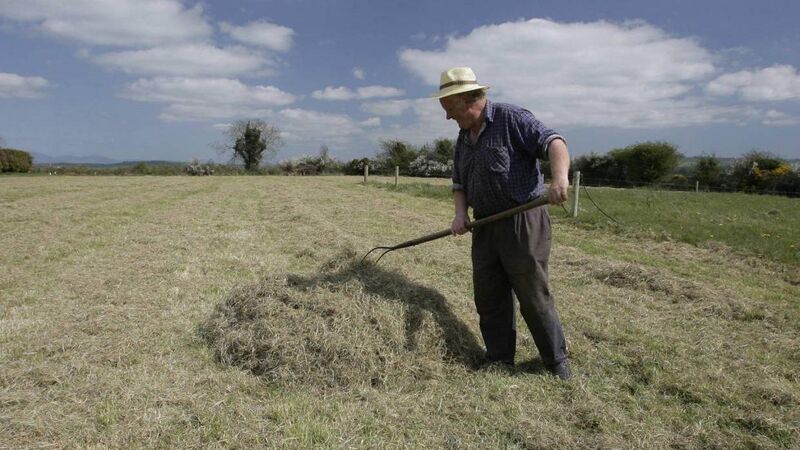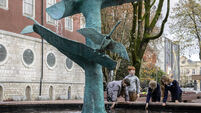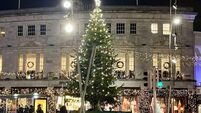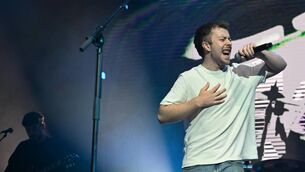Tales as Gaeilge, of forts, fields and Blonde Sheila of the Knife

Yes, I have a great grá for our native tongue, though I could never get the hang of Irish grammar, but then again, things like an tuiseal ginideach and an tuiseal laithreach aren’t that important.
Around this time of the year half a century ago, I was in a quandary, pondering my future. My prospects of pursuing an academic career or indeed entering any kind of third, fourth or fifth level educational institute were only middling!
After completing my Leaving Cert exams in June of 1974, the livin’ was aisy - well, for a few months anyway. We had a decent run at club level in hurling - though it was our near neighbours in Cnócain na Biolraí, or Watergrasshill, who were ag ceiluradh - yes indeed, they were celebrating well into that winter and they after winning the County Junior hurling title, fair play to them.
That August morning in St Colman’s, when I opened the envelope with my Leaving results, was truly a watershed in my life, but at 17 years ní raibh fhios agam, no, I didn’t realise what getting A in Honours Irish and No Grade in Pass Maths would mean.
Gan dabht, I would have loved to have got Honours in English and History, too but ni mar a síltear a bhítear - what do they say about the best laid plans of mice and men?
I would have liked to study things like Old Irish and the history of early Irish civilisation - before St Patrick arrived on these shores. So it came to pass that I enrolled in the great University of Life and my mind’s boundaries were framed by the Glen, the Bog, the Chapel Field, the Well, the Mass Path and other small and big, mighty and insignificant physical features.
I loved always hearing the stories, the scéalta, from the Scanlons - Tom and Martin and their mother Johannah - she was born in 1882.
Ciss Geaney, who lived to be over 110, was a witty and sharp lady - she told me that when she was growing up, ‘the Arnolds were big people... and ye’ve nothing now’!
My Auntie Jo was born in 1911 and spent a lot of summer holidays in her mother’s ancestral home at Ballard, Castlelyons. She told me that when any serious matter not suitable for younger ears was being discussed by the older generation, the ‘elders’ would speak in Irish - the influence and teaching of an tAthair Peadar Ó Laoighaire made a lasting impression in gach aon paroiste where he ministered.
I’ve often said that ’twas my National School teacher Donal Ó Liathain who fostered my love of Gaeilge. A native speaker, Donal had beautiful Irish, spoken so naturally, yet when he got a bit angry he’d raise his voice and begin with ‘Well, Blazes Kate anyway...’ There was no Irish for that, but we understood him alright!
And, you know, staying at home to farm the ancestral acres meant I was close to the fields, boreens, roads, and rivers that wove the pattern which made ‘my place’ so special.
I remember 20 years ago, at our National School reunion, Dick Barry, former TD and born in the parish, relating his travels. He said he might have been in Dublin or Brussels, yet when he drove up Hollyhill to the Cross, he got a special feeling.
His father Patrick, or Patsy Barry as his former pupils called him, was a great gatherer of lore and stories which he published in a series of books. He had conversations with people who lived through the Famine - we think it’s so long ago, but in reality it’s but a few generations.
Maybe the Sagart was a Celtic or Pagan priest who lived here and breathed in this air a thousand years ago? We’ll probably never really know, but I do love to be ag smaointe ar rudaí mar sin - thinking about things like that.
On the first Ordinance Survey Map of Ireland, in the 1830s, there were literally thousands of forts, lioses and raths shown dotted all over the country. Different names for basically the same kind of circular structures, which were the first ‘dwellings’ of our ancient ancestors.
Built from earth, wattles and timber, and often thatched, they provided shelter for man and beast alike. Built from materials racy of the soil, when stone building came into fahion the lioses and raths were left abandoned. Soon, they were known as fairy forts and I suppose gan dabht the ‘fairies’ or spirits or souls of long gone generations still frequented these places, and so they became revered locations.
The biggest field we have is - I never actually saw it written down ‘officially’, Parkalasa, well, that’s how we pronounce it anyway. The meaning as Gaeilge is Páirc an Liosa, or the Field of the Lios or Fort.
I can still trace the outline, and a semi-circle of the outer rampart , in a C shape, is now part of the field ditch.
Níl fhios agam, sure, over centuries words and meanings get jumbled and a bit tri na ceile, like myself as some might say!
I just loved the nearby name of Sheelaboonaskeane’s Castle - just the ruins remain today, but still clearly visible - maybe seven or eight hundred years on since Blonde Sheila of the Knife dwelt there ach sin sceal eile - yes, truly a story for another day or night.
Up the road from us is Cooneennasprioda, the Corner or Turn of the Spirit or the Ghost.
In the Bottom Bog once was an IRA hide-out and possible arms dump during the War of Independence.
Up the boithirín and across the bothar is what we pronounce as ‘The Kill Field’, ach, no-one was done to death ansin.
The lime kiln was like a towering inferno. Layer after layer of furze, turf and timber was interspersed with the limestone. The whole lot was set on fire and burned away for a few days. When the job was done and the fire burned out, the rocks were reduced to powdered lime for spreading on the land. Every parish, farm and field have their own personal sceal to tell.
Táim cinnte gur Gaeilge a labhairt na daoine anseo long, long ago - yes, there’s no doubt in my mind that the beautiful, musical Gaeilge is as much part of our heritage as the sky over us or the sod ’neath our feet.







 App?
App?







